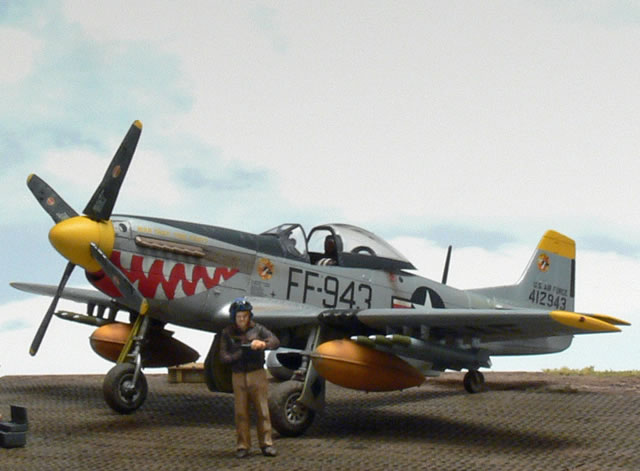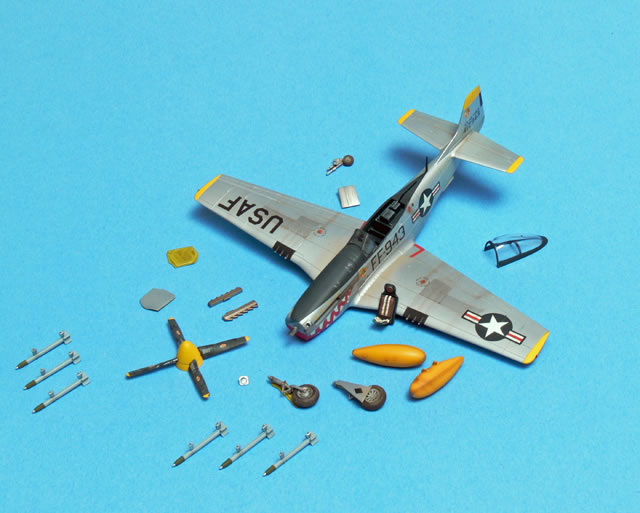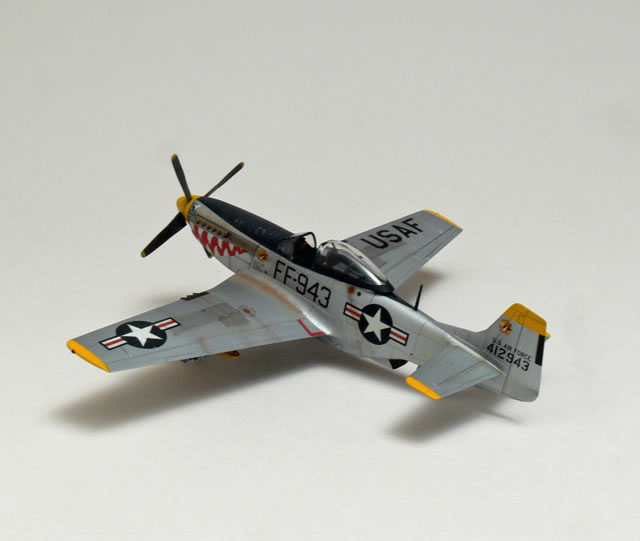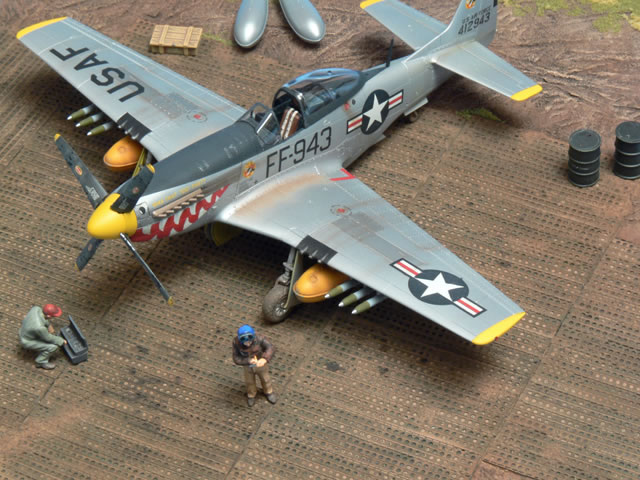|
Tamiya's 1/72 scale F-51D
Korean Mustang
by Rafe Morrissey

|
North American F-51D Mustang |

Tamiya's 1/72 scale F-51D Mustang is available online from Squadron.com
I have always been fascinated by the F-51 in Korea. Seeing aircraft in non-traditional markings is always interesting and certainly, the most common image conjured up by the P-51 is in its role as an escort fighter with the 8th Air Force in World War II. That’s why, to me, the use of the plane as a ground attack aircraft during the Korean conflict is so unique. The F-51 suffered one of the highest loss rates of any U.S. aircraft involved in the war, so its selection by the Air Force to fill a role so contrary to its original purpose is also curious. In any case, I was compelled to build my P-51 as an F-51 and enjoyed the end result. The process of getting there was a different story.
You may notice that unlike my earlier articles, there are almost no in-progress photos. That is because this actually represents my fifth attempt at building a 1/72 scale P-51. Hyperscale is replete with numerous articles on various techniques for building aircraft and natural metal finishing techniques, so I don’t presume to offer anything new here. I think perhaps the most important thing I can offer is to those folks just entering the hobby which is a reminder not to be discouraged if things don’t always go right the first time. Even an experienced modeler gets tripped up and in my case, it happened four times in a row! – Never give up!

Attempt 1:
Looking for a quick build to take on vacation, I grabbed an old 1/72nd Hasegawa P-51 thinking I would build it as an F-51 and add rockets from my spares box. This was the original kit with the raised panel lines and I was OK with that but decided I would at least scribe the cowling panel lines. I did a fair job of scribing too but in the process of sanding out mistakes and rescribing several times I found out that the nose was now about 1/16” narrower than the prop spinner.
Lesson learned: Be careful working the seams on in-line aircraft where the spinner must match exactly with the fuselage.
Attempt 2:
When I got home I dug out the updated 1/72nd scale kit that Hasegawa released in the 90s with recessed panel lines. It went together very nicely and all was well until I began to paint the natural metal finish. As it happens the bottle of Alclad II must have been from the bad batch a few years ago as it refused to dry. After numerous attempts to fix the paint, temper took hold and it met an abrupt end against my model room wall.
Lesson learned: Always test any paint before spraying it on a model!

Attempt 3:
Not willing to admit defeat I ordered a replacement kit and started again. All was well until I added the wing assembly to the fuselage. I can’t figure out why as I built it the same way I had the previous kit, but the fit was such that the wings had a negative dihedral instead of the slight dihedral of the prototype. Now having just build the same kit, I didn’t bother to test fit the major components, so all I could do was carve out the wing roots to achieve the proper angle. Unfortunately, the work left scars that could not be concealed by the natural metal finish. Strike three!
Lesson learned: Always test fit!
Attempt 4:
This was getting old! I guess stubbornness comes with old age, but I was more determined than ever to have my Korean War F-51. I had purchased a Hobby Boss kit at the same time I got the replacement Hasegawa kit thinking it might be fun. Well I built it up but to be honest the shape of the finished model just didn’t compare to the other kits. The Hobby Boss kit is very anemic throughout the entire nose area and just looked wrong.
Lesson learned: If accuracy matters, examine the kit closely before building.

Attempt 5:
Finally near to admitting defeat, I decided to make one last try. Tamiya has a 1/72nd scale kit already on the market. I also had a couple Academy kits with Korean markings in my stash but keeping in mind the lesson above, I looked at them closely and realized that they weren’t going to look enough like the real thing to satisfy me, so I called the good people at Squadron mail order and within a week, had the Tamiya kit in my hand. Boy what a difference 20 bucks makes. It was definitely more expensive but you can’t argue with how nice it is. Accurate proportions, nice detail and excellent fit are a great combination. The only complaint I have with the Tamiya kit is the fact that the clear portion of the main canopy is separate from the frame leaving a tough seam to fill that forces the modeler to either paint over the glass or to confront an unsightly distortion caused by the edge of the canopy.

Fortunately by this time, I had one of the most complete spare parts bin of 1/72nd scale P-51 parts in the western hemisphere so I was able to use one of the Hasegawa canopies. It is nicer in every respect than the Tamiya parts in that it is in one piece with lightening holes molded into the framework.
I used Alclad II Aluminum, Dark Aluminum and Steel for the finish (after testing each bottle on an index card!) I also used Tamiya acrylics for the detail colors and anti-glare panel and applied small chips with a Prismacolor silver pencil. MiG earth pigments added a level of grime to the wing roots and the “Brett Green” mix of XF-1 Flat Black and XF-64 Red Brown helped create the exhaust staining, powder burns and fuel spills.

For the base, I painted up a PSP base I acquired from a friend. I used Polly Scale acrylics and MiG Pigments to paint and weather the base. I added a Preiser mechanic figure and a pilot from the recent CMK USAF Korean War Figure set. It is one of 3 figures in the package and is one of their better efforts.
Lesson learned: You can’t go wrong with Tamiya!
Models, Description and Images Copyright © 2010 by Rafe Morrissey
Page Created 15 April, 2010
Last Updated
15 April, 2010
Back to HyperScale
Main Page

|
Home
| What's New |
Features |
Gallery |
Reviews |
Reference |
Forum |
Search